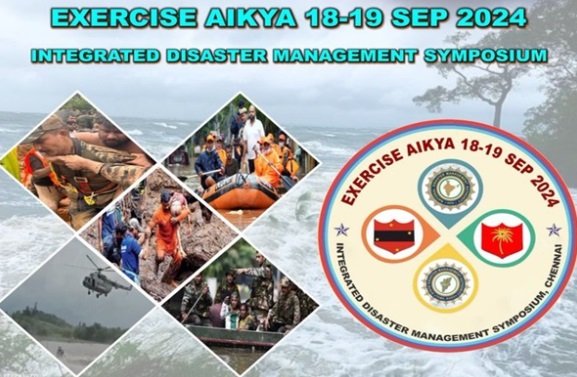Exercise AIKYA, a two-day national event organized by the National Disaster Management Authority (NDMA) and the Army Southern Command in Chennai, is a vital step toward strengthening disaster management strategies in India. With an increasing number of natural disasters worldwide, the need for cohesive and efficient disaster response has never been more critical. Exercise AIKYA aims to improve coordination and preparedness between various organizations, ensuring that India is better equipped to handle future disasters.
Aims and Objectives
The primary focus of Exercise AIKYA is to foster improved collaboration and readiness among key stakeholders responsible for disaster management. Through a series of practical exercises, including simulations and interactive discussions, participants will explore ways to leverage technology for enhanced disaster management. The event provides an opportunity to assess the effectiveness of current protocols and devise new strategies to deal with disasters more efficiently.
Key Participants
The event has drawn participation from a diverse range of departments, highlighting the importance of an all-encompassing approach to disaster preparedness. Representatives from sectors such as Railways, Transport, Civil Aviation, Health, Environment and Climate Change, as well as State and National Disaster Management Authorities, have all come together. The Indian Army is also playing a significant role, demonstrating the necessity of military involvement in large-scale disaster response.
Additional contributors to the event include officials from key institutions like the Indian Meteorological Department (IMD), the National Remote Sensing Centre, the Central Water Commission, and the Forest Survey of India. Their expertise will be critical in addressing some of the major disaster-related challenges faced by the country today.
Focus Areas
The discussions at AIKYA will cover a range of pressing issues, including tsunamis, landslides, floods, forest fires, cyclones, and recent disasters that have impacted India and the world. The event will delve into the prevention of these disasters, focusing on both short-term preparedness and long-term management strategies. By examining recent events, participants can draw valuable lessons to implement more effective responses in the future.
Knowledge Sharing and Capacity Building
One of the key objectives of Exercise AIKYA is to promote knowledge sharing among participants. By learning from each other’s experiences, attendees will gain a deeper understanding of best practices in disaster management. This exchange of ideas is crucial for building capacity and skills that can be employed in future disaster preparedness initiatives.
Strategic planning will also play a significant role during the event, as participants work together to create actionable solutions to improve disaster management practices. The goal is to ensure that organizations are better equipped to respond to any disaster swiftly and effectively.
Understanding Disaster Management
Disaster management follows a structured approach that includes four essential steps: mitigation, preparedness, response, and recovery. Effective disaster management means planning ahead, and this is where the Sendai Framework comes into play. This global plan aims to reduce disaster risk by emphasizing proactive preparedness, especially in the face of climate change, which accounts for over 90% of disasters globally.
The U.S. Federal Emergency Management Agency (FEMA), established in 1979, offers a model for disaster management, particularly in how early warning systems can mitigate the impact of disasters by up to 30%. Local community involvement has also proven to enhance resilience, as these grassroots efforts lead to quicker and more effective responses during crises.
Disaster Risk Reduction (DRR) strategies are pivotal for ensuring long-term safety and sustainability, focusing on how to minimize the effects of disasters before they occur. Training exercises, like those conducted during Exercise AIKYA, are fundamental in improving disaster response readiness. These drills allow participants to practice and refine their skills, ensuring that all agencies involved can function as a cohesive unit during real emergencies.
The Role of Technology
Technology is a critical component of modern disaster management, offering real-time data, monitoring, and communication during disaster events. The use of advanced systems enables responders to assess situations quickly and accurately, helping to save lives and reduce damage. AIKYA’s focus on integrating technology into disaster response will ensure that India stays ahead in its disaster preparedness efforts.
Summing Up
Exercise AIKYA is not just a training event; it is a significant step toward building a more resilient nation in the face of disasters. By bringing together key agencies, encouraging the exchange of knowledge, and focusing on technological advancements, the event underscores the importance of collective responsibility in disaster management. As natural disasters continue to rise in frequency and intensity, initiatives like AIKYA will be instrumental in ensuring that India is prepared for any eventuality, safeguarding lives, property, and the environment.


